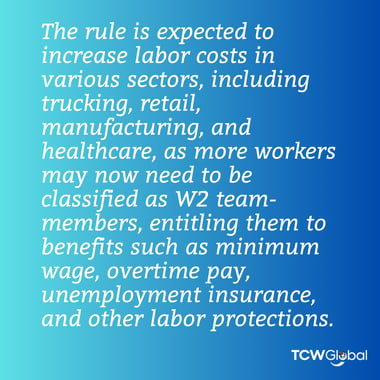Biden Administration Set to Introduce Independent Contractor Classification Regulation Potentially Transforming the Gig Economy

January 12, 2024

Biden Administration Introduces New Independent Contractor Regulation, Potentially Transforming Gig Economy
Overview of the New Rule
The U.S. Department of Labor, under President Joe Biden's administration, has issued a final rule aimed at defining a W2 employee versus independent contractor status. The rule favors employee status, with hopes of curbing the misclassification of workers as independent contractors.
[This rule is set to replace a previous regulation from the Trump era, which allowed greater leeway for companies to classify workers as independent contractors.
The final rule emphasizes a multifactor, totality-of-the-circumstances analysis to determine a worker's status, focusing on economic reality factors such as opportunities for profit or loss, investments by the worker and the employer, the permanence of the work relationship, the degree of control, the extent to which the work is integral to the employer's business, and the worker’s use of a specialized skill.
In essence the Biden administration uses a detailed and comprehensive approach to decide whether a worker should be classified as an W2 team-member or an independent contractor.
This approach, known as a "multifactor, totality-of-the-circumstances analysis," considers various factors to understand the real-world situation of a worker. Here's a breakdown of what this involves:
- Opportunities for Profit or Loss
- Investments by Worker and Employer
- Permanence of the Work Relationship
- Degree of Control
- Integral Part of the Employer's Business
- Worker’s Use of Specialized Skills
Basically, the rule doesn't just look at one single factor but considers multiple aspects of the worker's role and relationship with the employer to get a full picture of their employment status.
The rule also does not provide guidance to courts on how to weigh the factors, but rather that they should be balanced against each other. This comprehensive approach aims to simplify classifying workers and ensure they receive the appropriate benefits and protections more accurately.
Nearly 40% of U.S. workers, or more than 64 million people, did some freelance work in the past 12 months, according to a December survey by freelancing marketplace Upwork.
Here's What The Biden Administration Aims to Accomplish
-
Enhancing Worker Protections
- Background
Historically, the U.S. labor market has seen a trend towards the increasing use of independent contractors, particularly in the gig economy. This shift can lead to workers missing out on key legal protections and important benefits.
- Objective
The new rule aims to ensure that workers who should be properly classified as W2 team-members receive the full spectrum of labor protections, such as minimum wage, overtime pay, health benefits, and unemployment insurance.
-
Aligning with Judicial Precedents
- Legal Consistency
The Biden administration's rule seeks to bring federal policy back in line with judicial interpretations of the Fair Labor Standards Act (FLSA). The previous administration's rule was seen as a deviation from these established legal norms.
- Reducing Misclassification
By aligning with judicial precedent, the administration aims to decrease the likelihood of worker misclassification, ensuring that the legal criteria for determining a worker’s status are clear and consistently applied.
-
Promoting Fair Business Practices
- Competitive Disadvantage
Businesses that correctly classify workers as W2 team members often face higher labor costs than those that misclassify workers as independent contractors. This creates an unfair competitive advantage for businesses that skirt labor laws.
- Leveling the Playing Field
The new rule aims to create a more equitable business environment by ensuring that all businesses adhere to the same standards for worker classification.
Implications for Gig Economy and Other Industries
This change is particularly significant for the gig economy, where companies like Uber, Lyft, and DoorDash rely heavily on contract labor. The rule is expected to increase labor costs in various sectors, including trucking, retail, manufacturing, and healthcare, as more workers may now need to be classified as W2 team-members, entitling them to benefits such as minimum wage, overtime pay, unemployment insurance, and other labor protections.
Reaction and Potential Impact
The rule has garnered mixed reactions. Worker advocates and some Democratic officials have praised it, arguing that it is necessary to ensure basic protections for workers and to address the issue of misclassification. On the other hand, business groups and some industry representatives have criticized the rule, claiming it could reduce flexibility for workers and lead to a loss of income opportunities. They also argue that the rule may force companies to reevaluate their use of independent contractors, potentially stifling certain types of gig work.
Legal Challenges and Enforcement
The Department of Labor's shift from the Trump-era regulation is expected to be the focus of legal challenges. Federal law mandates that agencies must adequately explain their decisions to withdraw and replace existing rules. The Biden administration asserts that the Trump-era rule violated U.S. wage laws and did not align with federal court decisions.
Economic and Social Considerations
The rule addresses concerns about the economic well-being of workers. Studies and reports indicate that regularly misclassified workers, such as truck drivers, construction workers, and home health aides, may earn significantly less than their counterparts classified as W2 workers. The rule aims to rectify these disparities and ensure fair wages and benefits for workers. However, it also raises questions about the cost implications for businesses and the overall impact on the economy, especially considering that a significant portion of the U.S. workforce engages in freelance work.
Final Thoughts
The Biden administration's final rule on worker classification marks a significant shift in labor policy from the federal level, aiming to provide greater protections for workers at the potential cost of increased business expenses and legal complexities. TCWGlobal will closely watch the implementation and the resulting legal and economic impacts in the coming months. Please be aware that many states have more stringent requirements for independent contractor compliance that may need to be factored into your classification analysis as well.
How We Can Help
TCWGlobal, as a global employer of record (EOR), can be highly instrumental in helping companies navigate the complexities introduced by the new rule changes regarding worker classification.
Guidance on Compliance
We provide expert advice on the latest labor laws and regulations, including the Biden administration's final rule on worker classification. We can help companies understand the nuances of the rule and its implications for their workforce.
Worker Classification
Our team can assist in determining the correct classification for either W2 workers or independent contractors by performing the new multifactor, totality-of-the-circumstances analysis on each worker submitted for independent contractor status.
Mitigating Legal Risks
We can help companies mitigate legal risks by ensuring that workers are classified in compliance with the final rule, thus avoiding potential legal challenges and penalties.
So why wait? Give us a call today!
Need Help?
Whether you need expertise in Employer of Record (EOR) services, Managed Service Provider (MSP) solutions, or Vendor Management Systems (VMS), our team is equipped to support your business needs. We specialize in addressing worker misclassification, offering comprehensive payroll solutions, and managing global payroll intricacies.
From remote workforce management to workforce compliance, and from international hiring to employee benefits administration, TCWGlobal has the experience and resources to streamline your HR functions. Our services also include HR outsourcing, talent acquisition, freelancer management, and contractor compliance, ensuring seamless cross-border employment and adherence to labor laws.
We help you navigate employment contracts, tax compliance, workforce flexibility, and risk mitigation, all tailored to your unique business requirements. Contact us today at tcwglobal.com or email us at hello@tcwglobal.com to discover how we can help your organization thrive in today's dynamic work environment. Let TCWGlobal assist with all your payrolling needs!

